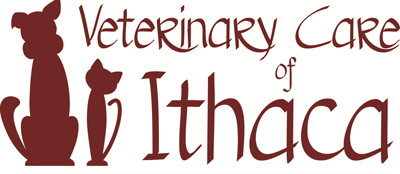Newsletter
The veterinarians and staff at Veterinary Care of Ithaca are pleased to provide you with an online newsletter. This fun and fact-filled newsletter is updated on a regular basis.
Included in the newsletter are articles pertaining to pet care, information on our animal hospital, as well as news on the latest trends and discoveries in veterinary medicine.
Please enjoy the newsletter!
Current Newsletter Topics
June is Adopt-A-Cat Month – Here’s How to Find the Right Purring Companion
Using the NO Word
Excellent Dental Care For Your Pet
Pet Diagnostics: The Benefits of Endoscopy
Grief Counseling by Phone After Losing a Pet
June is Adopt-A-Cat Month – Here’s How to Find the Right Purring Companion
You may have heard the saying, “You own a dog, but you feed a cat.” It is true that cats value their independence a bit more than their canine counterparts. But, if you’ve ever been around cats, you already know they crave and require love and companionship. Cats make wonderful pets and most easily adjust to a variety of lifestyles and living spaces. Every cat is a true individual though, so it’s important to take the time to choose a four-footed friend who’s right for you. A cat’s personality, age, and appearance, as well as the kinds of pets you already have at home, are all things you should keep in mind when making your selection.If you’ve ever been to a shelter, you have probably noticed that some cats meow and head butt the cage door while others simply lie back and gaze at you with a look of total ambiguity. There are as many different personalities of cats as there are cats in the shelter. Which disposition is best for you? YOU have to decide.
Regardless of individual personality, look for a cat that is playful, active, alert, and comfortable while being held. At the shelter, ask an adoption counselor for assistance when you wish to spend some time with individual cats. Because they are in an unfamiliar environment, some cats that are usually quite social may be frightened or passive while in the shelter.
As a general rule, kittens are curious, playful, and full of energy, while adult cats are more relaxed and less mischievous. Kittens also require more time to train and feed. Cats are only kittens for a few months, though, so the age of the cat you adopt should really depend on the level of maturity you are looking for. Young children usually don’t have the maturity to handle kittens responsibly, so a cat that is at least 4 months old is probably the best choice for homes with young children.
They All May Be Cute, But Which Is Right For You?
Though dogs also have differences in coat, choosing the length of coat on a cat is a little different. Because the hair is generally finer and cats generally shed more, hair length can be an important part of your decision. Cats can have long, fluffy coats or short, dense fur and the choice between the two is chiefly a matter of preference, availability, and your willingness to devote time to regular grooming. Short-haired cats are generally easier to come by since they’re the most popular and the most common. Keep in mind that long-haired cats require frequent grooming to remain mat-free. Felines with short coats also require brushing, though less frequently. Most cats enjoy a regular brushing and look forward to this daily ritual.
If you already own a cat or dog, you’re probably wondering how easy it is to add a cat to the family. The good news is that cats can get along with other cats, and despite the common stereotype, most dogs can get along with cats too. Unfortunately, introducing a new cat to a home with other pets can be time-consuming and require patience on your part.
The best way to handle adding a new cat to the home is to provide time for a period of adjustment. You can do this effectively by isolating your new feline in a room of his own for a while, something that is a good idea for a new cat anyway. After several days, supervise meetings between the animals for periods of increasing length. Most cats will soon learn to accept each other. Some dogs simply won’t tolerate the presence of a cat, but by carefully introducing them, most problems can be solved.
No matter which kind of cat you choose, remember that you’re making a commitment to love and care for your new feline friend for his or her lifetime. That could mean 10, 15, or even 20 years. So choose your new companion carefully and be a responsible pet owner. In no time at all, you’ll know how wonderful sharing your home with a cat can be.For more information about Adopt-A-Cat month, please visit the American Humane Association’s website.
Using the NO Word
Almost without fail, people use one word too much and incorrectly when raising a puppy. The word is “No.” Some puppies hear it so often they think it’s part of their name: “JoeNO!” “MeganNO!” Used constantly and, especially if used in a whiny, pleading manner, “no” loses its value as a training tool.
“No” should be delivered firmly and sharply, as guttural as a low, barky growl—comparable, in other words to how a puppy’s mother expresses her displeasure. Don’t whine at your dog: “No, no, no, no. Mommy’s fluffums is bad, bad, bad!” Instead, throw the word at the pup.
Because of the overuse of the word, some trainers suggest using another sound especially for correction, something that lends itself more naturally to sounding like a growl, like “arrrggghhh.”
Excellent Dental Care For Your Pet
A complete examination of all surfaces of the teeth is impossible to perform while the veterinary patient is awake. The external surface of some teeth may be superficially examined, but the inside surfaces of the teeth (within the oral cavity) cannot be evaluated unless anesthesia or deep sedation is administered.
Laboratory blood tests along with an ECG and radiographs are often necessary before a dental patient can be anesthetized. The older the patient, the more tests that may be needed prior to administering general anesthesia. Animals with congenital diseases and pets suffering from chronic conditions are a greater anesthetic risk than completely healthy pets. If your pet is considered an anesthetic risk, your veterinarian will recommend the tests that are necessary prior to administering anesthesia.
The anesthesia given to one pet may be completely different than the anesthesia given to another pet. Your veterinarian can choose from a variety of pre-anesthetic medications and anesthesia induction agents. After the pre-anesthesia medication and induction agents are administered, general anesthesia is usually maintained with a gas agent (isoflurane or sevoflurane) mixed with oxygen. Monitoring the anesthetized patient is a fundamental procedure in veterinary medicine.
One or more of the following monitors may be used:
- Electronic Respiratory Monitor
- Pulse Oximeter
- Blood-Pressure Monitor
- Electrocardiograph (ECG)
- Esophageal Stethoscope
- Carbon Dioxide Monitor
Along with patient monitoring, it is important to keep the pet warm and comfortable during the dental procedure. Since many procedures may last longer than an hour, the pet’s core body temperature may become lowered. By using blankets, hot water bottles, and heated tables, the veterinary patient’s body temperature can be maintained at its normal value.
Anesthesia or deep sedation is necessary for oral examination and dental cleaning because:
- Dental tartar is firmly attached to the surface of teeth and needs to be removed.
- Scaling by ultrasonic scalers and sharp hand instruments are necessary in order to remove the dental tartar.
- Any sudden movement can cause injury to the animal or individual performing the dental procedure.
- Dental scaling is performed above and below the gum line. Scaling the teeth above the gum line usually does not cause discomfort, however, scaling below the gum line (can cause discomfort. The area below the gum line, or subgingival space, is the most important area to clean as periodontal disease begins here.
- Humans cooperate during dental procedures, however without anesthesia or deep sedation, dogs and cats do not.
- Scaling above the gum line offers nothing but cosmetic results. Scaling must be done below the gum line.
During the last few years, veterinary dentistry has made tremendous strides. By taking advantage of the dental procedures offered at your veterinary hospital, your pet can enjoy the benefits of having excellent teeth well into his or her senior years.
Pet Diagnostics: The Benefits of Endoscopy
Endoscopy is a minimally invasive diagnostic medical procedure commonly used to evaluate the interior surfaces of an organ by inserting a small tube into the body. Through the endoscope, the observer is able to see lesions of organs and other internal medical conditions. Endoscopy means “looking inside.”
In veterinary medicine, endoscopy is commonly used as a diagnostic procedure, for tissue and organ biopsies, to remove foreign objects (particularly in the stomach) or get an inside view of a particular part of your pet’s body. Even though anesthesia is required to keep your pet still during the endoscopic procedure, the amount of anesthesia and recovery time is greatly reduced. Literally meaning “to look within,” endoscopy is often indicated when routine blood and urine tests, radiographs, and ultrasound do not give the complete diagnostic picture.
The endoscope is composed of a long tube (flexible or rigid), a light source, camera, and viewing eyepiece. In addition to the fiber optic light source, there are two channels within the tube. One channel is for passing forceps, snares, or biopsy instruments, allowing for the removal of foreign objects, collection of biopsy samples, and removal of small polyps or tumors. Air or water can be passed through the other channel for better viewing of the tissue or organ.
One can distinguish:
- The endoscope itself, consisting of either a rigid or flexible tube
- A light delivery system to illuminate the organ or object under inspection
- A lens system transmitting the image to the viewer from the fiberscope
- An additional channel to allow entry of medical instruments to biopsy or to facilitate tissue and other operations
The benefits of endoscopy include shortened anesthetic time, decreased inflammation, less physiologic stress and discomfort, and an earlier return to normal function. The endoscope is used to help diagnose and treat a variety of gastrointestinal and respiratory disorders. Depending on the symptoms, it is used to look at the inner lining of the throat, stomach, intestine, colon, or at the respiratory passages (nose, throat, and lungs). Even though general anesthesia is required for an endoscopic procedure, it is still considered much less invasive than traditional surgery, due to the relatively short procedure length and low occurrence of complications.
Grief Counseling by Phone After Losing a Pet
If you are struggling with the grief accompanying the loss of a pet or just want to talk about your feelings with someone, there are many support lines available. You can search for support groups and resources in your area or consider calling any of the following:
ASPCA – 800-GRIEF-10
Chicago Veterinary Medical Assoc. – 630-325-1600
Cornell Univ. – 607-253-3932
Iams – 888-332-7738
Michigan State Univ. – 517-432-2696
SPCA Of Texas – 214-461-5131
Tufts Univ. – 508-839-7966
Univ. of Illinois – 217-244-CARE
Univ. of Tennessee – 865-755-8839
Utah State Univ. – 435-757-4540
Washington State Univ. – 866-266-8635
ASPCA
Chicago Veterinary Medical Assoc.
Cornell Univ.
Iams
Michigan State Univ.
SPCA Of Texas
Tufts Univ.
Univ. of Illinois
Univ. of Tennessee
Utah State Univ.
Washington State Univ.
Grief Counseling Hotline
Pet Loss Support Hotline
Pet Loss Support Hotline
Pet Loss Support Hotline
Pet Loss Support Hotline
Pet Grief Counseling Support Line
Pet Loss Support Hotline
C.A.R.E. Pet Loss Helpline
Veterinary Social Work Helpline
Pet Loss Support Hotline
Pet Loss Hotline
Phone Number
800-GRIEF-10
630-325-1600
607-253-3932
888-332-7738
517-432-2696
214-461-5131
508-839-7966
217-244-CARE
865-755-8839
435-757-4540
866-266-8635
Get In Touch
We've proudly served the pets of Ithaca, NY for over 30 years.
Contact Info
Address

Hours
Sat: 8 am - 12 pm
Sun: Closed
Have a question?
Get in touch with our team! Complete the form below, and a member of our team will be in touch with you shortly. If you're in need of immediate assistance, please call us directly at 607-273-3133.

Request your next appointment online!
Save time and easily request your next appointment with us from any device.
